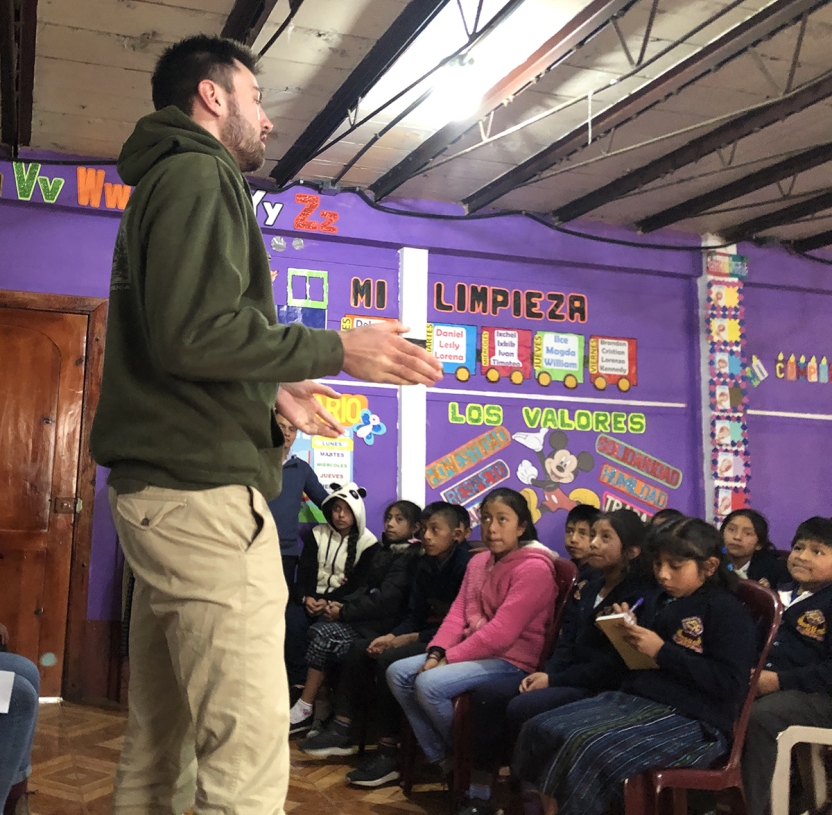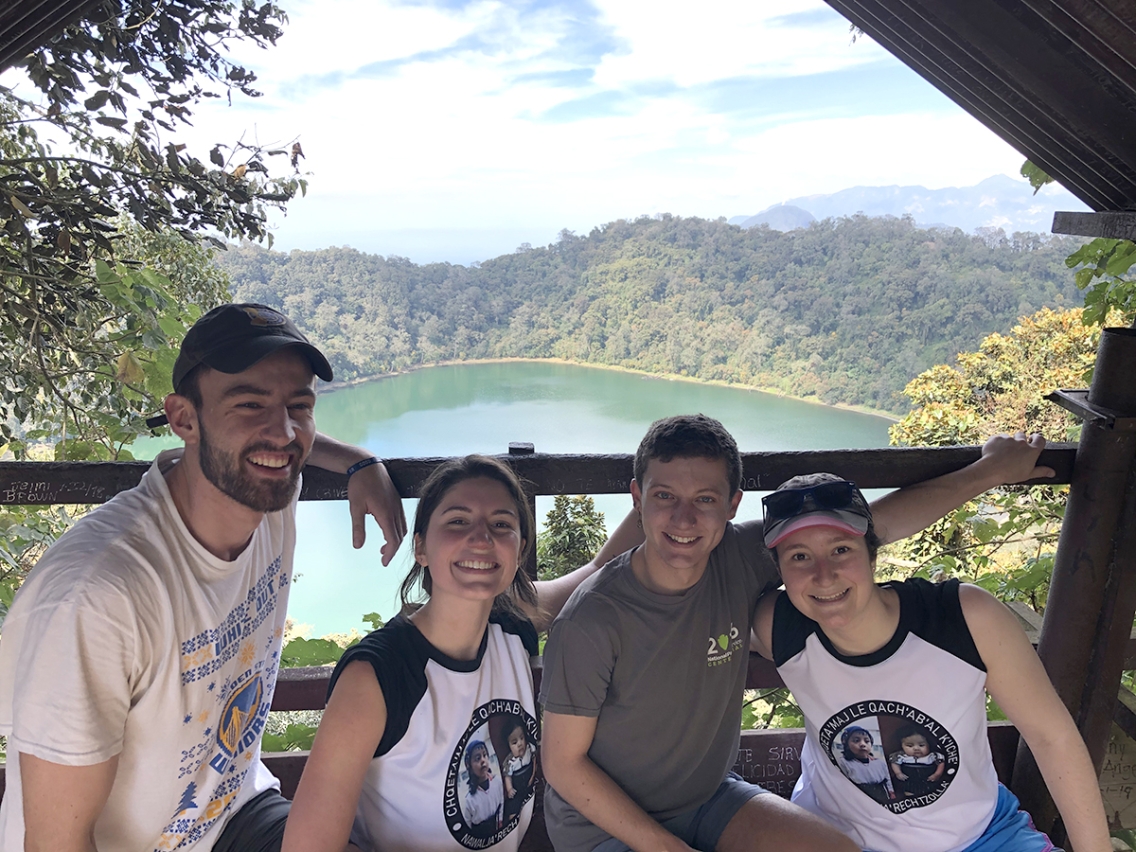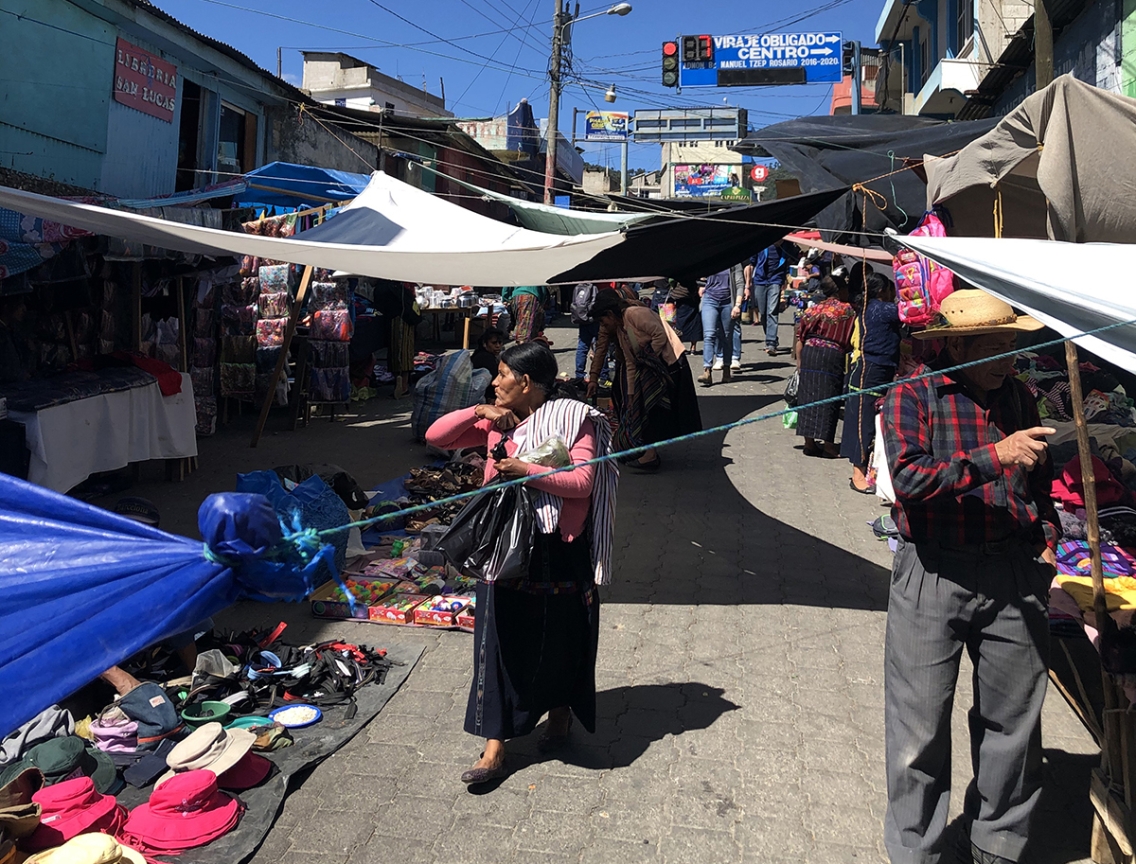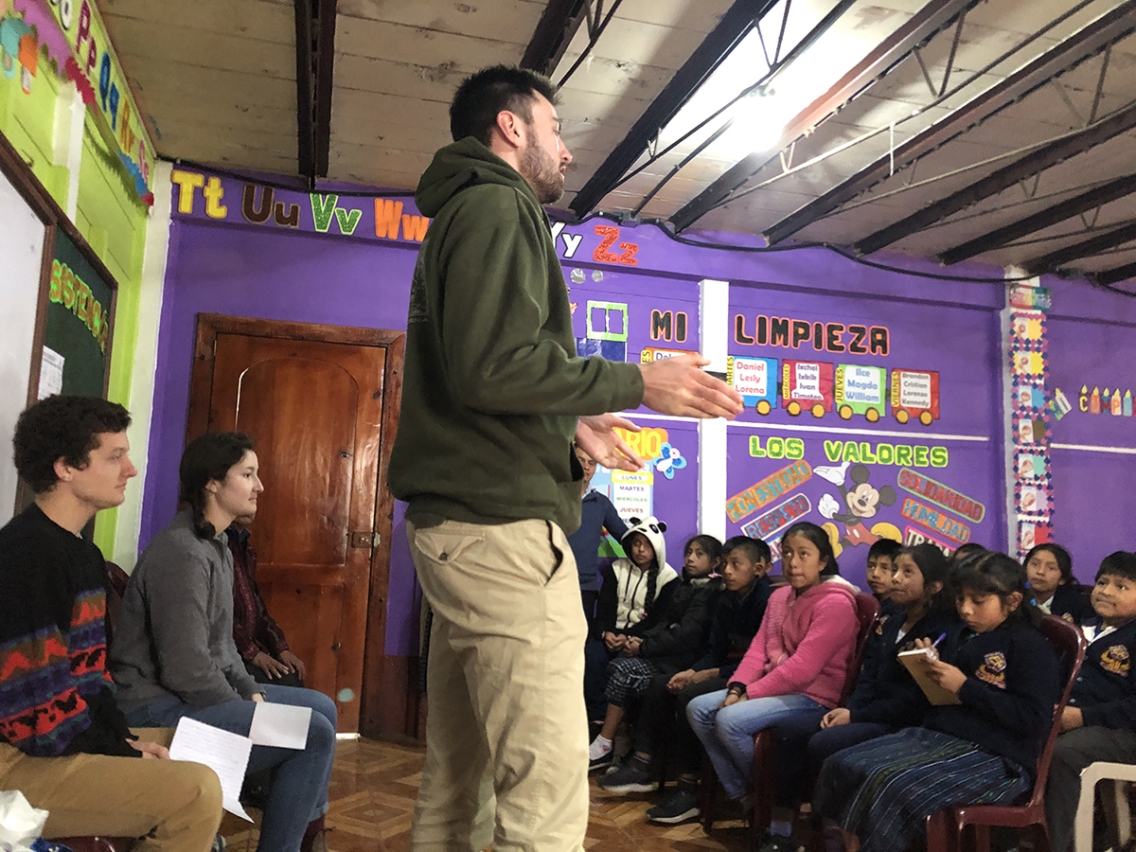Students Assist with Mayan Language Revitalization Project

MIDDLEBURY, Vt. – “Saqarik!” (sah-kah-REEK!) “Good morning!”
So began presentations to grade schoolers in Nahualá, Guatemala, given by four Middlebury students as part of a Mayan language revitalization project this past January. The project was led by Associate Professor of Luso-Hispanic Studies Brandon Baird.
“The school kids would always laugh when they heard us speak in K’iche’,” said senior James Finn. “A lot of the kids and just people in general see Americans and expect them to speak English, so when they heard us speaking in Spanish they were surprised. And then when they heard us speaking, you know, K’iche’, it was like, ‘Whoa, what’s going on here!’”
Baird says that part of their revitalization work is overcoming a social stigma. “People there have been raised hearing—and it has been supported by the government—that speaking a Mayan language makes you less of a person, makes you inferior. It means you’re not as smart as someone else who speaks another language, particularly, in this case, Spanish.”
To counter such myths and attitudes, Baird and his students presented at local grade schools, distributed posters, and recorded live on the national K’iche’ radio station, Nawal Estéreo, in Nahualá. The topic: current research on the benefits of bilingualism in terms of neuroscience, linguistics, and psychology. Bilingual speakers, for example, are better at critical thinking and problem solving; better able to adapt to social situations; and better at speaking and understanding both languages.
Research even suggests they are less likely to develop dementia, have more gray matter in their central nervous systems (making them “smarter”), and can earn more money.
January’s project grew in part, said Baird, out of his desire to give back to a community that’s been so welcoming to him. He has been conducting research on indigenous language aspects of Spanish linguistics in Guatemala for over a decade. Since 2012, he’s focused on Nahualá, a town of some 60,000–70,000 in Guatemala’s western highlands. Concerns about losing their language is something that residents have shared with him from his earliest stays.

From left: James Finn ’20, Sabine Poux ’20, Jack Carew ’20, and Lila Sternberg-Sher ’21 enjoy the view of a high-altitude lake from the top of a mountain near Xela.
“I did my dissertation on intonation in both languages [Spanish and K’iche’], which has to do with the rhythmic patterns with which people speak, but for part of it, I just needed to get straight-up speech from the people, open-ended conversations about whatever they wanted to talk about. Most participants talked about the importance of their language, the importance of their culture, revitalizing it, how they fear they’re losing it to a more Ladino [Hispanic] culture.”
K’iche’ is estimated to have over a million speakers and is among the approximately 30 Mayan languages still spoken today.
Language, traditional dress, and traditional rituals, said Baird, are central to the ongoing Mayan Movement, which began in Guatemala in the late 1970s and has continued its resurgence since the ending of the 36-year civil war in 1996.
At Middlebury, Baird won a Gladstone Award for Excellence in Teaching to support the January Mayan language revitalization project and began working with students last fall. Before heading to Guatemala, the group spent a week on campus, studying K’iche’, digging into research on the benefits of bilingualism, and learning about Mayan culture.
Alongside these preparations, Baird engaged his students in hard questions about how to contribute meaningfully as outsiders.
For history major James Finn ’20, these questions were especially important given the history of U.S. intervention in Guatemala and the ways that history continues to affect current affairs, including migration north.
“I think one of the things we learned,” said Finn, “that we’ve talked about a lot and then you hear a lot learning about the Mayan Movement, is that language becomes synonymous with culture. And Mayan culture has been so aggressively oppressed and persecuted in Guatemala under the government; and as Americans we’re complicit in that oppression because of our government’s history.”

Jack Carew, a senior, noted that “for so many years, the language you spoke in Guatemala was the defining factor as to whether you were Mayan or Ladino. So if you speak a Mayan language, then you’re Mayan; if you don’t, regardless of your heritage, then you’re not. That was the defining factor for whether genocide was committed against you. When it’s that serious and the stakes are that serious, who are we to come in?”
A key ethos, said Baird, is “that we are not the experts. As much as I’ve been going to Guatemala for over a decade now, and no matter what, no matter how many people I talk to and what research I do and stuff that I publish, I will never be the expert on it.”
“Another thing we talked about in class,” Baird continued, “is when you’re doing a project like this you really need to make sure that you’re welcome. So over the years doing research, whenever I went, I would always reach out to whoever the current mayor was and say, ‘This is what I would like to do, and I would like your permission to be here in Nahualá to do this.’”
A key partner in January’s project was former Nahualá mayor Manuel de Jesus Tahay Gomez. Baird and Tahay Gomez (whom the group called by his Mayan name Tat Wel, meaning “father” or “Mr.” Manuel) became friends when Baird first arrived in Nahualá. Two years ago they did a radio presentation on the importance of K’iche’, and the broadcast was so well received the two put their heads together and began planning what became this January’s effort.
In Nahualá, the group worked side by side with Tahay Gomez as they presented on the benefits of bilingualism. Typically, Middlebury students presented in Spanish, with Tahay Gomez or his daughter Manuela Tahay Tzaj (Nela) interpreting side by side; then Tahay Gomez, Tahay Tzaj, and Baird spoke in K’iche’. The group began their day at Tahay Gomez’s house, planning together, and then debriefed after each day’s activities.

Sabine Poux ’20, a political science major who’s also editor in chief of the Middlebury Campus, had interned at an Argentinian radio station during a semester at Universidad Torcuato Di Tella, in Buenos Aires. So she was especially drawn to the radio broadcast.
“I love seeing how radio stations work in different places, different contexts, and it was fascinating to see radio used as a sociolinguistic tool,” she said.
Carew—who’s studied Arabic, Spanish, and Mandarin; studied abroad in Jordan and Chile; and conducted independent research in Jordan and Israel—took the opportunity to dive in on K’iche’.
“I had my composition book where I’d written down a lot of K’iche’ on the plane and when we had a minute I’d turn to Nela and be like ‘How do you say this word?’ or ‘What is that word?’ or ‘Oh I know that if you put an X at the beginning of a word, that makes it past tense.’”
Junior Lila Sternberg-Sher, an independent scholar in linguistics, appreciated the ways the host families introduced them to aspects of Mayan and Guatemalan culture. Corn, for example, is so important that the K’iche’ name for Guatemala, Iximulew, means “land of corn.”
“I’ve always been really interested in food and think that it’s a really cool way to learn about cultures,” said Sternberg-Sher. “And every single meal they would make tortillas. At one point, our host sister was making one, and I was like, ‘Could I maybe … Can you show me how to do it?’ And she was like, ‘Come and try.’ Mine was horrible. It was all cracked on the outside. But it was a really cool experience.”
One of the most thought-provoking experiences for all four came out of the discussions with teachers before each school presentation. Using the facts and myths about bilingualism as a starting point, the teachers shared their own experiences as K’iche’ speakers in a place where Spanish is the marker of prestige.
“A few different teachers shared personal experiences they’d had of relatives who had forgotten how to speak K’iche’,” said Finn. “And one said, ‘You know this, this is showing me, these posters and the conversation we’re having are showing me why it’s so important to speak K’iche’ with the younger people and to teach it in the schools.’”
“One teacher was saying that he has a two-year-old daughter who he speaks with mostly in Spanish, and he told us, ‘After hearing what you guys have to say, I want to change how I communicate with her and speak more K’iche’, because I realize now the importance of being bilingual,’” said Sternberg-Sher.
“Seeing what this project meant to Tat Wel really meant a lot to us,” said Poux, “like when we sat down with the teachers and he was talking about our project and what K’iche’ means to him.”
Baird recounts Tat Wel telling the Middlebury students: “‘A lot of us remember when we were kids and we would go to school and they would beat us if we spoke K’iche’ in school.’ And I think that hearing him say that, talking about his personal experience, is infinitely more profound than anything that I could have ever taught the students in the classroom.”

